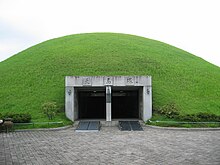Jijeung of Silla
| King Jijeung 지증왕 智證王 | |||||
|---|---|---|---|---|---|
 King Jijeung's tomb | |||||
| King of Silla | |||||
| Reign | 500–514 | ||||
| Coronation | 500 | ||||
| Predecessor | Soji of Silla | ||||
| Successor | Beopheung of Silla | ||||
| Born | 437 | ||||
| Died | 514 Silla | ||||
| Burial | Cheonmachong | ||||
| |||||
| Father | Galmunwang Seupbo | ||||
| Mother | Lady Kim | ||||
| Jijeung of Silla | |
| Hunminjeongeum | 지증왕 |
|---|---|
| Hanja | 智證王 |
| Revised Romanization | Jijeung wang |
| McCune–Reischauer | Chijŭng wang |
| Birth name | |
| Hunminjeongeum | 김지대로 |
| Hanja | 金智大路 or 金智度路 |
| Revised Romanization | Gim Jidaero |
| McCune–Reischauer | Kim Chidaero |
| Monarchs of Korea |
| Silla |
|---|
| (Pre-unification) |
|
|
Jijeung of Silla (437–514) (r. 500–514) was the 22nd ruler of the Korean kingdom of Silla. He is remembered for strengthening royal authority and building Silla into a centralized kingdom.
Like many Silla kings, Jijeung was of royal blood on both sides. His father was the Galmunwang Kim Seup-bo, who was a grandson of Naemul Isageum. His mother was Lady Josaeng, the daughter of Nulji Isageum.
Jijeung began his program of legal reform in 502, when he outlawed the custom of burying servants with their masters. In 503, he formally established the country's name as "Silla," it having previously been represented by a variety of Chinese characters. At the same time, he took the title of wang, meaning "king"; he had previously borne the native Silla title of maripgan.
Jijeung continued this program in the following years, with a reform of ceremonial dress in 504 and of local administration in 505. In that reform, he incorporated the old territory of Siljik-guk into the Silla administrative system. He established a market in eastern Gyeongju in 509. In 512, he sent Kim Isabu to conquer the island nation of Usan-guk.[1]
After his death, Jijeung received a temple name, the name by which he is now known. He was the first Silla king to receive a temple name.
King Jijeung's tomb is believed to be Cheonmachong.[2] The height of the deceased at Cheonmachong is estimated to be around 5 feet 3 inches (160 cm).[3]
Family
- Father: Galmunwang Seupbo
- Mother: Lady Kim
- Wife: Queen Yeonje of the Park Clan (연제부인박씨)
- Son: Beopheung of Silla (r. 514–540 AD) - the 23rd monarch of Silla
- Son: Galmunwang Ipjong
- Grandson: Jinheung of Silla - the 24th monarch of Silla
- Son: Kim Ajinjong (김아진종)
See also
References
- ^ "General Isabu of Silla Kingdom Incorporated Dokdo into Korean History". KBS World. December 29, 2011. Retrieved 12 March 2024.
- ^ "백55호 고분은 지증왕릉". JoongAng Ilbo (in Korean). 1973-09-19. Retrieved 2024-01-17.
- ^ ""慶州(경주) 155號(호) 古墳(고분) 金冠(금관) 「榮華(영화)의 主人(주인)」은 누구"". The Chosun Ilbo (in Korean). 1973-07-29. Retrieved 2024-01-17.
Jijeung of Silla Born: 437 Died: 514 | ||
| Regnal titles | ||
|---|---|---|
| Preceded by | King of Silla 500–514 | Succeeded by |
 | This Korean history-related article is a stub. You can help Wikipedia by expanding it. |
- v
- t
- e











